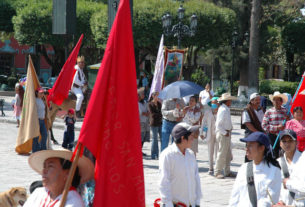November is a festive month here in Ajijic, beginning with the celebrations of All Saints Day and Day of the Dead, and ending with the feast of the village’s patron, San Andrés.
Invariably the most lively celebrations in any Mexican village, the fiestas patronales here seem possessed of a unique spirit of mirth unmatched in other nearby localities. While some might attribute this to massive consumption of alcohol-laced canelas and canteritos , it is my belief that the tone comes from an uncanny coincidence–the first day of the fiestas just happens to be November 22, the feast of Santa Cecilia.
Martyred c. 200 A.D. for refusing to honor the pagan gods of Rome, Saint Cecilia is said to have unflinchingly faced her fate–including being thrown into a boiling bath and several failed attempts at beheading–by singing to God in her heart. She is thus regarded as the patron saint of musicians.
While there is no particular cult to her in this village, no church or chapel in her honor, it would seem that Santa Cecilia keeps a special watch over its habitants. The love of music, both active and passive, is pervasive here. Take a morning walk about the village and you’re bound to pass by open doors through which you’ll hear housewives singing along with the radio as they sweep and mop and hand-scrub mounds of laundry. You’ll notice that no construction site is complete without a boom box blaring ranchero tunes. And deep in the night you may awaken to interrupted silence, a solitary voice coming out of the darkness, passing by, fading away in the distance, an unknown someone whose soulful song breaks a dark, staggering pathway home from the cantina .
Naturally, no wedding, quinceañera or other important social occasion is complete without live music for dancing. And dance they do. It’s an activity relished so universally in Mexican society that it defies the generation gap. We gringos , more sedate by nature, are often astonished to see how children and teens shake and shimmy side by side with adults–young, middle-aged and seniors–without the slightest inhibition.
It is equally intriguing to discover that music is a widely popular sideline activity among villagers. Step out in the evening for a private party or dinner at a local restaurant and you’re likely to find yourself being entertained by someone with whom you’ve done business in course of the day. Pancho Aguayo owns and operates the barber shop just up the street from the plaza. Gerardo Rojas is head honcho at his family’s popular bakery. Both moonlight as musicians.
Armando Paez is a restaurateur who also entertains his patrons by playing guitar and singing popular Mexican tunes, including his own composition Mi Lindo Ajijic . The Hinojoso family not only holds key roles in management at the La Nueva Posada Hotel, but likewise forms the core of musical entertainment in its restaurant and bar.
Then there’s the remarkable Medeles family. While Victor Manuel, a young composer of growing renown, is the only Medeles brother to have pursued music as a profession, his siblings Jesus, a veterinarian, Angel, a dentist, and other members of this large clan have learned to play a wide array of instruments for pleasure and profit. Their father, a man distinguished not only for his own mastery of various musical instruments, but also for being the only man in town who can tune a piano, instilled a deep appreciation for music in his offspring by making it the focus of their family life.
Performing individually or together as a combo, the Medeles brothers always delight audiences with their diverse repertoire of Mexican and other genres.
For the Medeles’ and the Hinojosos, for many Ajijic families, music is an element of daily life as essential food and air and sunlight. Some days even more so. As dawn breaks on November 22 we will all awaken to the strains of the town band, known by the playful moniker Los Sordomudos (the Deafmutes). All morning long they will wander the cobblestone streets, offering up rousing tunes in praise of Santa Cecilia, that wonderfully familiar sound, our wake up call for fiesta-time!



